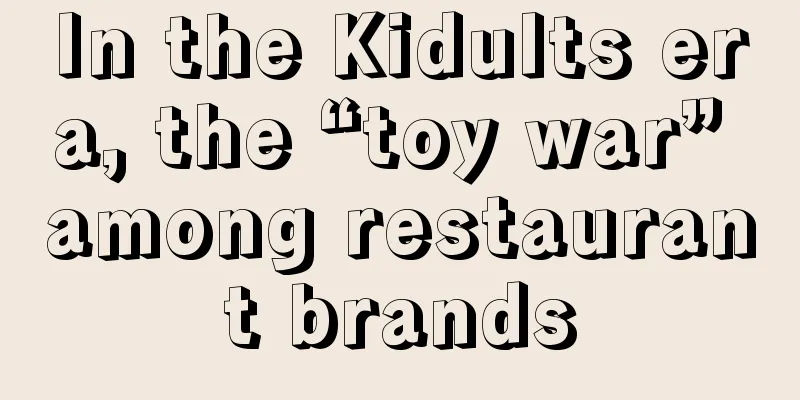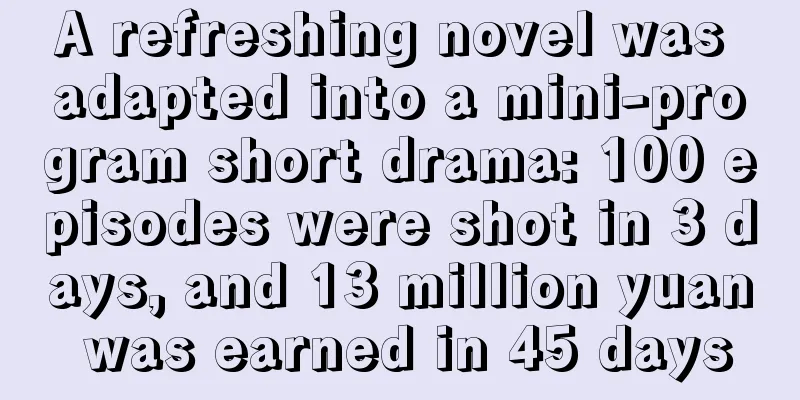In the Kidults era, the “toy war” among restaurant brands

Every May and June, a group of adults scramble to buy children's meals at KFC and McDonald's. This has become a regular occurrence. The year before last, it was a singing Psyduck, last year it was a game console in the shape of Chicken McNuggets, and this year it is a FM-adjustable McMillian walkie-talkie. From Xiaohongshu to Douyin, from Taobao to Xianyu, the theme of Children's Day is different every year, but "McMillion" and "K-Ke" are always part of the social currency. Since the first Happy Meal was launched in the 1970s, this fast food toy has become popular. Even today, some people still enjoy collecting fast food toys, and those colorful little toys with the marks of time have also transformed into medals to commemorate childhood over the years. Nowadays, in addition to Maimen and K-Jie, more and more catering brands have joined the toy competition. Pizza Hut has joined hands with Sanrio, Dicos has launched Garfield, Wallace has invited Calabash Brothers, and Le Caesar Pizza has collaborated with Chibi Maruko-chan. Regardless of how much the actual sales volume has been boosted, the social influence of the childhood filter cannot be ignored. In fact, due to the continuous evolution of the consumption environment and brand culture, the needs of this generation of consumers have changed. People are more inclined to consume brands that can satisfy emotional value, even if it is just ordering a cup of milk tea or eating a fast food meal. In fact, many brands have already won small victories through this kind of "interaction". 1. Not just McDonald’sOn social media, some people were thinking about how to use McDonald's intercom to rule a one-kilometer radius, while others were thinking about how to use a can of rubber ducks to summon a giant "billing duck." Yes, the June 1st limited edition of Maimen and K-Jie has become a regular marketing campaign for some new tea brands over the past few years. Previously, the lemon tea brand Linli had launched a gift of ducklings. This low-cost but cute toy became popular among young consumers as a gift with meals. For consumers, a cup of lemon tea that costs about 10 yuan may not be a gimmick, but those colorful ducks of different shapes and colors belonging to the same series inexplicably arouse the public's desire to collect them. On Xiaohongshu, if you search for "duck", a bunch of guides will pop up. 10 small ducks can be exchanged for a medium duck, and 3 medium ducks can be exchanged for a big duck. At the same time, various strange alien ducks will be randomly dropped, such as angel ducks, demon ducks, rabbit ducks, and even golden yellow ducks. No one can refuse a little yellow duck that brings back childhood memories - as long as you open the takeout bag, it will bring back all the Chinese people's memories of the little duck. The bright yellow, round duck once floated in every Chinese child's red bathtub. It has a plastic texture and an empty belly. If you squeeze it hard, it will make a sharp sound. So, no matter how you feel about the meal gifts themselves, as long as you get this little yellow duck, the valve of memory will naturally open. It is no surprise that some people would come to Linli just to collect ducks. In addition to Linli, other new tea brands also give away small toys with orders. The little crocodile from Lemon Season and the bitter melon pig from Tea Saves the Planet have all been displayed on the computer monitors of tea lovers. From McDonald's walkie-talkies to ducks in the woods, these carefully crafted little toys are obviously not prepared for children, but gifts for adults. It is even impossible to verify the antiquity of the little yellow duck. The Pokémon game was born in 1996, Pikachu premiered in 1999, and the first episode of Calabash Brothers dates back to 1989. These co-branded IPs and toys are all childhood companions of the 90s and 00s generations. Why is it that instead of targeting real children, they are marketing toys to adults? And why does it work? 2. The era of “kidults”A survey conducted by market research firm NPD Group may be able to explain this. Adults have long viewed childhood toys as nostalgic, comforting or collectible, which has spawned a nickname in the toy industry: kidults. From adult Happy Meals to Barbie movies, the purchasing power of kidults has been verified. Statistics from NPD Group also show that people aged 18 and above account for 14% of the sales in the US toy industry, with a growth rate of 19%. At the same time, the China Toy Association's tracking of Taobao sales data shows that the growth rate of adult toys has exceeded that of children's toys. A set of latest data from Taobao Factory shows that in the current children's toy market, the proportion of toys bought by college students born after 2000 for playing house has reached more than 40%. This is the so-called "Kidults" era. It represents a phenomenon in which adults have or pursue interests, consumption behaviors, and lifestyles similar to those of children or adolescents. This trend reflects that a portion of adults in contemporary society continue to have the characteristics of adolescence in terms of psychology and behavior. They still have an interest in toys, games, cartoons, pop culture, etc., and may regard these as part of their lives. This phenomenon also has an impact on business and culture, such as the emergence of a series of products, entertainment activities and market trends targeting "kidults". To some extent, the toy marketing of food brands and the toys bought by college students for pretend play are, in a clever way, opening a ventilation window for tired adults. The public's memories of childhood are always filled with optimism and expectation, but when they enter the real world as adults, they often face the pressure of life. The cubicle-based social animals, the 996 culture and the ubiquitous workplace culture make people feel suffocated, and under pressure, the childhood filter becomes a window for breathing. Of course, the emergence of the "Kidults" era can also be attributed to a variety of factors, including improved economic conditions, increased cultural diversity, and technological advances. But most importantly, adults have more freedom and resources to pursue what they like without being bound by traditional adult roles. The little ducks and crocodiles arranged on the computer screen are not only playable and ornamental, but also serve as cultural symbols, allowing adults' OOTD to be dressed up with a childlike theme. 3. Consumption implications of a toyFrom the duck in the forest, the crocodile in Lemon Season to the bitter melon pig in Tea Saves the Planet, the way to check in with lemon tea has changed from photoshopping the cup to collecting small toys in the drawer. At present, for these brands, participating in this toy battle from time to time is the current demand and will become the next brand consensus. Just on Children's Day this year, many fast food chain brands participated, not to mention "Mai Men" and "K Kee". If you count them carefully, the brands have almost brought out all the childhood IPs of the 90s generation. Pizza Hut has chosen to collaborate with the Sanrio family to launch 6 limited edition toys, including the Hello Kitty music box, the Half-Mercury night light, the Pudding Dog bubble machine, the Big Eared Dog spray boat, and the Pacha Dog tableware set. There are many ways to play with them and they have different shapes. The collaboration between Chinese hamburger Tustin and Balala the Fairies pushed the term #Children dislike childish gifts, adults find them just right# to the top of Weibo's hot searches. The pink and purple balloon set and the butterfly-shaped bubble magic wand are a perfect reproduction of childhood memories. There is also the Garfield Hamburger launched by Dicos. The cute orange cat is paired with a plump hamburger, and its ugly and cute appearance has caused another crazy rush. In addition, Haidilao and Xiong Da and Xiong Er, Nayuki and Teletubbies, Le Caesar and Chibi Maruko-chan, Tai Er Pickled Fish and Crayon Shin-chan, Cha Baidao and Capybara... a series of IPs and toys have appeared on the screen, vowing to facilitate this childlike carnival for adults from all angles. Adults who pay for free toys may not necessarily fail to do the math. Even if the toys given with the meal are only sold for a few dollars on e-commerce websites, they are still willing to spend more time waiting for a limited-edition set meal. Because compared to a pure purchase, the "childlike" filter given as a gift is bigger. On the other hand, the reason why toy marketing continues to be popular is also due to the precise control of emotional premium. From the 38-yuan Maimai walkie-talkie to the free duck collection in the forest, these toys do not incur much additional decision-making costs for consumers. A cup of lemon tea, no matter what brand, is good to drink, and a little duck as a gift is even better. As for the co-branded toys that carry childhood memories, the price is only within a few dozen yuan, so the consumption burden is not high. Based on the above, it is enough to understand why toy marketing has become popular among many brands. Martin, a world-renowned marketing expert, wrote in his book Brand Brainwashing: "Our tendency to romanticize past times can explain why nostalgic marketing is particularly effective in times of economic instability. If the stock market falls, personal debt increases, climate change news is broadcast on TV, and job security has become a thing of the past, then at this time, uneasy consumers are looking for symbols of comfort food: sounds, smells, appearances, memories, and the familiar fonts of beloved brands from childhood. In other words, what we want is the era before adult troubles came." Standing at the crossroads of 2024 and looking at these toys, which era will be more stable, innocent, and interesting than the past? As Martin says, “Marketers know that as consumers we crave any remnant of our past, and not just in terms of food. For example, if we buy a set of Monopoly, a game of Ludo, or a Rubik’s Cube, we’re not just buying a toy or a game, we’re buying a journey back to our childhood.” Author: Salted Fish Source: Wu Duidui |
<<: Meituan Group Buying x Hu Ge: How to create a spokesperson advertisement for the whole nation?
>>: In the post-Li Jiaqi era, how can Taobao beauty products revive?
Recommend
Is cross-border e-commerce possible? How does it work?
Speaking of cross-border e-commerce, in fact, many...
Data people, how to "package" yourself as an industry expert?
This article systematically shares methods to quic...
How to open a cross-border e-commerce store? Introduction to preparations for opening a cross-border e-commerce store
There are actually quite a lot of merchants doing ...
How to open a store and sell things on the Wish platform? Can Wish allow me to open a personal store?
As a world-renowned online shopping platform, Wish...
Rethinking the “Subscription System”
Why is the subscription system becoming more and m...
WeChat releases major new rules regarding public account advertising!
The Internet industry is becoming more prosperous,...
New and old brands compete for the Spring Festival gift box market, lively but not innovative
The Spring Festival is approaching, and the festiv...
Shopee Advertising New Seller Rebate Benefits in October 2023
In October 2023, Shopee advertising new sellers wi...
A baptism: the end of the era of distribution and the reshaping of the global logistics chain
In the global e-commerce landscape, Chinese cross-...
JD.com leverages 100,000 sales force to follow Meituan’s lead
In 2025, the high-profile launch of JD.com's f...
Marketing Calendar | October is full of creativity, are you ready to celebrate the festival?
In October, in addition to the traditional Nationa...
How can brand digital humans that have lost their novelty break through?
Last year, virtual digital people were still popul...
What data analysis methods will you use?
Introduction: The main content of this article is ...
What products will be sold well on Amazon in 2023? Are hardware products selling well on Amazon?
Among many product areas, hardware products have a...
Finally, I talked about a male health blogger who sold over 3 million in a year.
In the field of health video bloggers, although mo...









